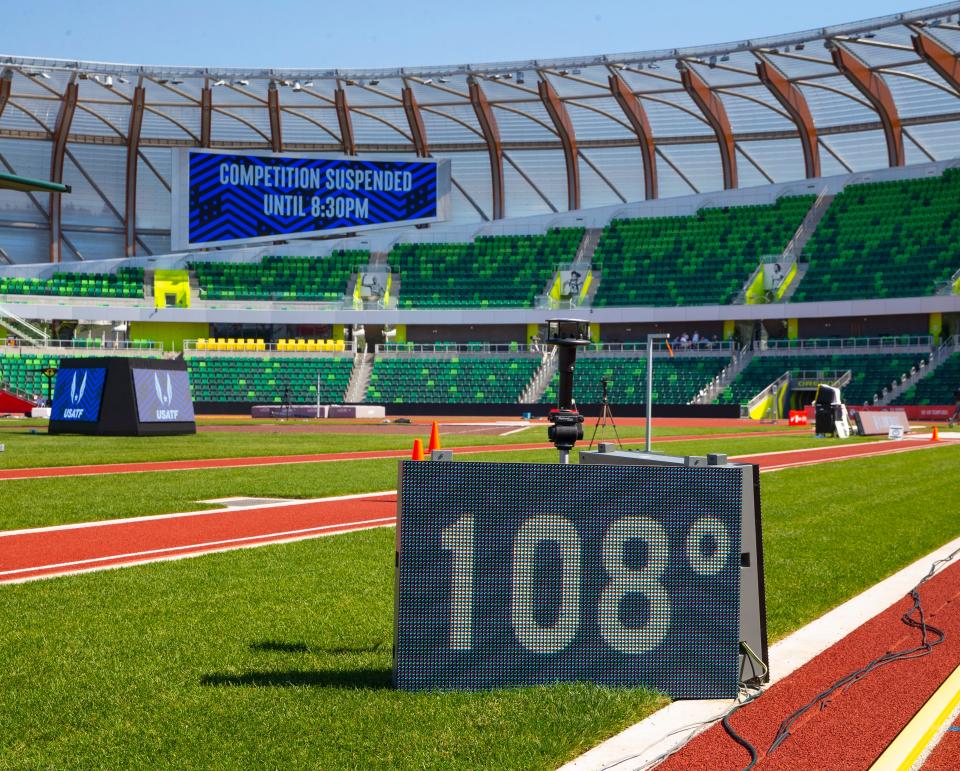Eugene endured its hottest summer ever, National Weather Service 2021 weather recap shows
June's historic heat wave and a string of dry summer days helped make 2021 the third-hottest year on record for Eugene and its hottest summer ever.
The year also included some notable daily and monthly record highs, according to the National Weather Service in Portland's 2021 weather recap.
June was tied for the hottest month based on records going back to 1895, with the two-day peak coming with a high of 103 degrees June 26 and a record-setting 111 on June 27 — the hottest day ever recorded in Eugene going back to 1890. More than 100 people died in Oregon due to the heat wave.
Meteorologist Tyler Kranz with the NWS in Portland said it's clear the climate is steadily warming in western Oregon and pointed to the office recently updating its new "normal" climate status with warmer temperatures between 2010 and 2020 as evidence.
"Heat waves in general should become more common over time, given our climate is becoming warmer," he said. "I wouldn’t be too surprised if we have another similar event in our lifetime."
Related: Eugene and Oregon set records for hottest summer in recorded history

Scorching summer
Signs of the summer's scorching weather first came in spring. April 16, for example, tied and then April 21 set the record for high temperatures, with highs of 80 and 83 degrees, respectively. April's 0.34 inches of rain was also the driest on record, breaking the record of 0.49 inches in 1985.
After the heat wave in June, July wasn't much different, and it was recorded as the second-hottest July on record for Eugene. Eighteen days in July had temperatures of 90 or higher. The highest temperature of July — 99 degrees — came July 29.
August brought another heat wave, but it turned out to be not as hot as June with highs of 102 on Aug. 11 and 104 on Aug. 12.
Those extreme highs fueled Portland and Eugene to the second-warmest year averages on record, at 56.5 and 55.1, respectively, while Salem (55.8) had its third-hottest year. All three were about 2.5 to 3 degrees hotter than a normal year.
Hot and dry years increasing
The first major rain came in mid-September, giving a much-needed soaking to Eugene. From June 15 to Sept. 15, Eugene had the driest weather ever recorded for that period, with just 0.01 inches of rain in July. Between those two showers, Eugene had gone 71 days without rain, and it would have broken a record without the miniscule rain in July.
Oregon's statewide average temperature was 49.2 degrees in 2021, which is 2.5 degrees warmer than normal and adds another recent year to the list of hottest years on record.
Grim ‘new normal’?: Oregon wildfires lay waste to 826,000 acres, set records for unhealthy air in 2021
Of the 12 hottest years ever recorded, eight have been recorded since 2000 and six have come since 2010, as climate change moves Oregon's weather closer to California than Washington.
Although it was also a dry year locally — and an exceptionally dry summer — the impact was far worse on the east side of Oregon, according to NOAA data from weather stations across the state.
"What's most concerning is that this was a La Niña year, when we'd traditionally expect colder or at least historically normal temperatures," Oregon state climatologist Larry O'Neill said. "Instead, we got extreme heat in the summer. We did have somewhat cooler weather in the winter, which is why this year didn't end up as the hottest."

A late December drenching allowed Oregon to make up a lot of ground in precipitation totals, finishing with a statewide average of 28.47 inches, which is 88% of normal or the 30th driest year on record in 127 years of data.
The Oregon Coast was actually wetter than normal in some areas and about normal temperature wise. The Willamette Valley ended the year slightly on the dry side — except in Salem — while towns east of the Cascades saw some of their driest years on record.
"That's our other big-picture concern," O'Neill said. "Both in terms of observed data and some new studies, there is evidence that the rain shadow is intensifying, which would be bad news for the east side of the Cascades.
"One worrying thing is that changes in climate is happening faster than we thought. It's not clear if this is just a rough couple of years or becoming a normal cycle. The local-scale impacts of climate change are the hardest ones to resolve."

Louis Krauss covers breaking news for The Register-Guard. Contact him at lkrauss@registerguard.com and follow him on Twitter @LouisKraussNews.
This article originally appeared on Register-Guard: Eugene endured its hottest summer ever, NWS 2021 weather recap shows

